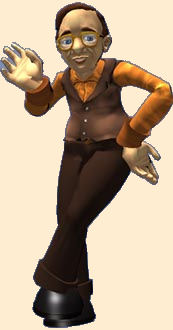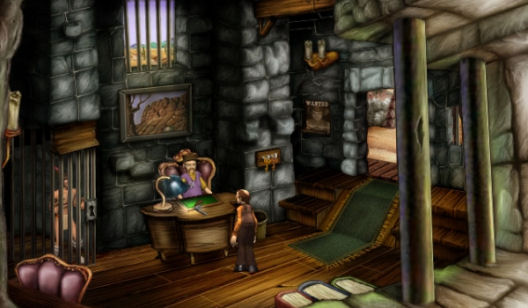|
GAMEBOOMERS TALKS TO BRITNEY BRIMHALL ABOUT AL EMMO AND THE LOST DUTCHMAN’S MINE by Becky Waxman
Chairman and CEO of Himalaya Studios, Britney K. Brimhall brings a tremendous amount of experience and enthusiasm to her work with classic adventures. Britney headed the team that produced popular remakes of King’s Quest 1 and 2; with an expanded team she is now producing Himalaya’s first original game -- Al Emmo and the Lost Dutchman’s Mine. This latest venture will attempt to rejuvenate the key elements of classic games, while introducing a new game world, comical story and a new kind of adventure hero.
As you’ve noted, Al Emmo is not your typical hero; he’s not tall, dark and handsome, nor a brawny, blonde hunk. We wanted to go for something unique, and decided that it would be fun to allow a geek to rise to the ranks of hero. Being a Woody Allen like protagonist offers some unique challenges when trying to hook up with the woman of your dreams, especially when your competition is a GQ cover boy type with royal heritage; it definitely makes the game more challenging as well as entertaining. Additionally, one of my favorite aspects of adventure games is gaining confidence through accomplishments. Being a baby and taking your first steps is a lot more confidence building than being a full grown human and taking a step. In a similar fashion, seeing a typical dweeb accomplish some pretty significant feats is more confidence boosting than merely being a superhero and doing what is expected of any leading man. Overall, there is significant character development, going from virtually a nobody to somebody worthy of major respect. Finally, being a typical dweeb gives the player, NPCs, and narrator plenty of opportunities to poke fun at the protagonist. Whereas in the beginning of the game, you’ll find yourself laughing at Al, by the end, you’ll begin to identify with him and consider him a pal. Before that point though, you’ll have many opportunities to laugh at him—by the end, you’ll be laughing with him.
I specifically chose the Southwest as a location because I was born and raised in the unrestrained deserts of Arizona. I have always been a desert enthusiast, and spent a lot of time in the nearby desert mountains studying the local flora and fauna. Growing up in Arizona, we spent a lot of time in school studying the local Indian tribes and botanical offerings as well, and for a period of time, I even worked in wildlife rehab, helping animal species native to the region. I’ve traveled to most regions of the state, from the red rock country of Sedona, to the breathtaking Grand Canyon, to the Imperial Sand Dunes on the Planet of Tatooine. There is so much cultural and environmental diversity in Arizona, that it really offers a treasure trove of opportunities when creating a land rife with adventure. The land of Anozira is based on different regions of Arizona, with a lot of creative freedom thrown in. Most of the people, puzzles, and locations in the game are based off of real life experiences, but again, with a creative twist. Additionally, the Legend of the Lost Dutchman’s Goldmine is a real historical event; the game is only loosely based on this real life legend, but for those who enjoy Al Emmo, it will be fun to research the actual story and perhaps go on a real life panning for gold adventure! Some people have voiced concern about the game being a “typical Western”, but I want everyone to be rest assured, that the setting and theme of this game are unique. It does not merely follow typical old West stereotypes. For anyone who has played the Quest for Glory series by Lori and Corey Cole, you will notice that those games use a well established culture to create an interesting gaming environment, but are not necessarily defined or restricted by it. Similarly Al Emmo is set in the Southwest, but is by no means merely a Western—this game breaks the typical “Old West” mold.
You will hopefully find riches in one way or another, although being true to your heart and being motivated by noble causes, you’ll come away with a lot more than merely material goods.
Check. Check. Check. Check. Check….and a whole lot more, including, but not limited to, beach babes, rabid prairie dogs, and Das Jan the journalist from adventuretreff.de!
No, the protagonist is on a mission that's mostly personal in nature. No warding off evil scientists threatening to destroy the valley. Heck, the place is so in the boonies that even if it WERE destroyed, the rest of the world wouldn't know about it for another decade or so. You do get the chance to protect, serve, woo and become somewhat of a hero, though.
Most puzzles are inventory based, but there are a variety of others as well. Some include code breaking, timing, trivia, brain teasers, action, and more. The puzzles are considered to be very fair and logical.
A lot of the puzzles were actually created based
on real life experiences growing up in Arizona. At other times, we’d
brainstorm and come up with puzzle ideas, and then add to them little by
little until we were satisfied with the final results. I would definitely
say that the puzzles were reworked quite often until we felt they were
challenging and logical. I could go into more detail as to how we came up
with certain puzzles, but am concerned that I would spoil the game. If
anyone has any questions as to how certain puzzles were created after the
game is released, we’d be glad to answer your questions on the official
Himalaya Studios forums. The game’s interface will feel very familiar to those found in the classic adventure games, although we’ve added some minor innovations. You’ll have easy access to inventory items and can scroll through them using the wheel in the middle of the mouse. To make travel more efficient, the player can double click to make the protagonist run. Additionally, you can click on the desired location, press the escape key, and immediately jump to the destination. Later in the game, the player also has the option of transporting to previously visited locations by using a map of the valley. The player
also has the option of turning visual effects, sounds, and text on or
off. The player has a lot of options, allowing them to play the game in a
way that makes him or her feel most comfortable.
I began playing adventure games back in the 80s. My dad was a typical computer geek, and came into contact with the Sierra classics. I enjoyed watching him play the King’s Quest series, and he encouraged me to play as well. We graduated onto other series like Space Quest and Police Quest, and eventually, I took a special liking to the Quest for Glory series and played those on my own. My dad unfortunately passed away when I was ten, and I found that because we’d bonded playing adventure games, I could still feel close to him by playing them after he was gone. I feel that adventure games offer a lot of unique opportunities that many of the other genres miss. A few of the aspects I really enjoy about adventures is the chance for social interaction; the opportunity to explore an expansive world; confidence boosting learning experiences; educational experiences; and scenarios and puzzles that work the player’s mind. Also, I enjoy the fact that adventures are a very personal experience. It reminds me a bit of going on a real life adventure, and coming away with a lot of positive memories. Others who have been on the same adventure can relate to you, and you can share stories, but still, the journey was a very personal and life changing one. I feel a lot of the current adventure games miss out on the details and humor that many of the classics had. We put a lot of time into creating unique background comments for every screen and really allowing the player to interact with everyone and everything in the environment. We also included a lot of fun idle animations, Easter eggs, and jokes that were not necessary, but add to the overall gaming experience. Additionally, a lot of games nowadays have become very realistic, abandoning the illustrated look of the past. We wanted to create a whimsical, fantasy world in a similar style to the classics, and felt the best way to accomplish this was through imaginative 2D background art.
Yet, although we love the nostalgic elements of the classics, we also felt the need to build on that foundation and offer the player even more. To do this, we asked ourselves what additional elements we would have liked to have seen in the classic games. Our answers led us to include the following: dynamically changing music which offers the player a unique experience each and every time; completely voiced narration, including narrator and protagonist interaction; 3D character models which allow for more complex and fluid character animation; the use of an export feature; the inclusion of special visual effects and sound effects; extremely detailed, high-resolution, high-color background art; lip synching and more!
We were lucky to have worked with some really dedicated, talented, and self-motivated individuals on the Sierra remakes over at AGDInteractive. When we decided to make Al Emmo, we invited many of our proven, loyal workers onto the Himalaya team. Since we did not have much experience using 3D animation, we scouted out additional talented workers and interns to join our team. As for voice actors, we advertised the character roles and held auditions. We had an excellent turnout, and eventually hired the people best suited to the roles and invited them to the recording studio. I think our team has remained motivated because we all share a similar goal of bringing back the classics. Additionally, every worker has a really hands on job; a huge amount of assets that they create will make it into the game—so, it’s very rewarding to create work, because you know it’s going to make a difference in the final product. Also, seeing assets posted on the forums is very motivating in itself. When I visit the forums and hear a fabulous new song, or read some hilarious dialogue, or see the newest 3D animation, it motivates me to be creative as well.
We plan on releasing Al Emmo and the Lost Dutchman’s Mine at the end of June. We will be selling it through the Himalaya Studios online store. After a customer places an order, a physical copy of the game will be shipped to them. We don’t have any concrete plans to localize the game or distribute it through stores, although we have spoken with a number of publishers, so this may one day be an option. It was a
joy working with you on this interview, and thank you for the
opportunity! I am excited for all of you to experience Al Emmo and the
Lost Dutchman’s Mine! |





